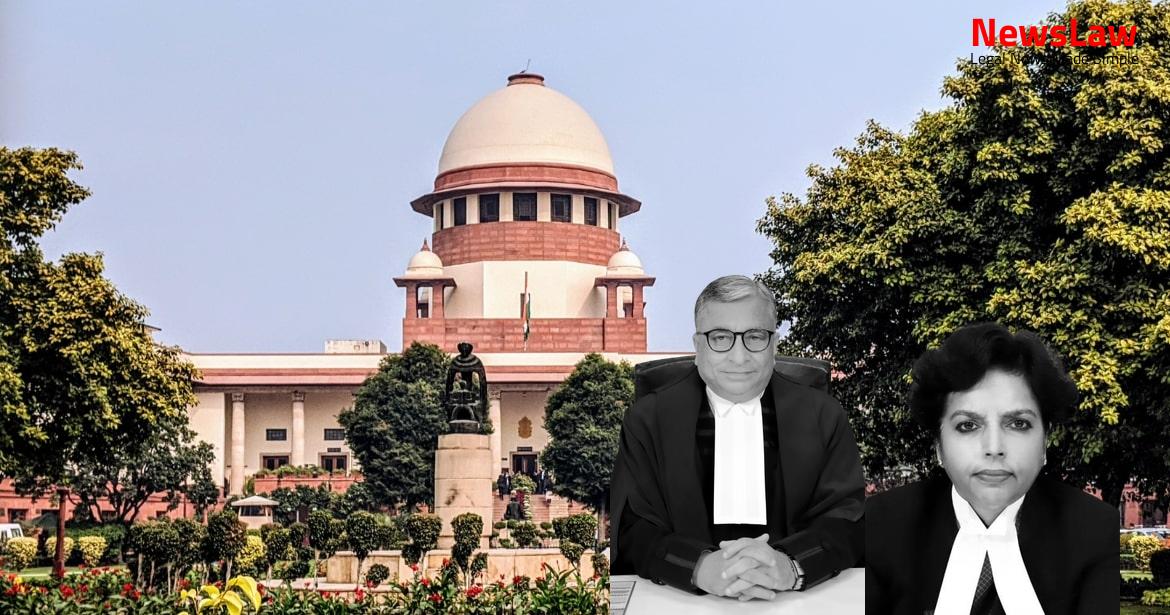Explore a detailed examination of how the court dissected the charges of conspiracy and evaluated the circumstantial evidence in a recent legal case. The legal analysis sheds light on the nuances of proving guilt beyond reasonable doubt based on circumstantial evidence and the requirements for establishing a criminal conspiracy. Dive into the complexities of legal reasoning and the importance of clear and conclusive evidence in determining the outcome of such cases.
Facts
- The Trial court convicted A-1 and A-2 for various offences, including theft, based on recovered cash receipts with slips from different banks
- The argument that bank account statements did not show any variation was rejected by the Trial Court
- The High Court upheld the conviction based on circumstantial evidence and testimonies of multiple witnesses
- The High Court confirmed the sentence with a reduction in imprisonment for one of the offences
- Accused no. 3 challenged the conviction and sentence in Criminal Appeal No 213 of 2006
- The Trial Court and High Court concluded that the Appellant was part of a conspiracy with A-1 and A-2 based on key custody
- The High Court reduced the sentence for one offence from six years to four years
- Testimonies of witnesses regarding key custody and access to Bank’s strong room and safe were crucial for the Trial Court’s decision
- The investigating officer seized the memo Ex. P-58 without evidence of breaking locks.
- The appellant helped a customer open a bank locker with his key, sensing a burning smell of petrol in the strong room.
- Currency notes and documents were found half-burnt and scattered in the safe.
- An amount of Rs. Six Lakhs was missing from the Bank custody, along with half-burnt currency notes worth Rs. 17,160.
- The appellant was charged with aiding in theft, house-trespass, destruction of valuable security, etc.
- The bank registers were found open and burnt, and the safe could only be opened with the appellant’s key.
- Three accused were prosecuted for theft, house-trespass, and destruction of valuable security.
- The theft was deemed impossible without the usage of actual keys.
- The appellant was confined to the existence or proof of a criminal conspiracy with the other accused.
- Money was recovered from one of the accused’s possession, leading to their conviction.
- The appellant was convicted and sentenced under Section 120B of the IPC for the same offences.
- The FIR was registered for offences under Sections 436 and 380 of the IPC.
Also Read: Judicial Review of Administrative Actions in Educational Matters
Arguments
- Shri Razdan submitted that the Trial and High Court correctly concluded findings based on well-appreciated evidence.
- No interference is needed with the judgment of the High Court.
- Ms. S. Janani reiterated the submissions made on behalf of A-1 and A-2 that no loss was caused to the bank as the entire stolen amount was recovered.
Also Read: Scope of Rule-Making Power in Disciplinary Proceedings
Analysis
- The argument that no theft occurred or loss was caused to the bank is not convincing.
- The conviction of A-1 and A-2 was based on evidence of theft and the recovered currency notes from A-2’s house.
- Mere recovery of stolen amount by the bank does not exempt A-1, A-2, or the Appellant from accountability.
- The Court must establish a clear chain of events ruling out the innocence of the accused.
- An express agreement is not necessary for conspiracy, but an implied agreement must be evident.
- Physical manifestation of the agreement is required based on circumstantial evidence.
- Mere transmission of thoughts sharing the unlawful act is not sufficient.
- The prosecution must prove the case against the accused beyond reasonable doubt.
- Conjecture or suspicion should not replace legal proof in cases dependent on circumstantial evidence.
- The charge of conspiracy must show explicit acts or conduct indicating a common design with others involved.
- Cumulative effect of proved circumstances should be considered, and each circumstance must be proven beyond reasonable doubt.
- Conscious and clear acts or conduct of the parties are necessary to infer their concurrence in the common design.
- Courts must ensure all incriminating circumstances are clearly established by reliable and clinching evidence to form an irresistible conclusion about the guilt of the accused.
- Absence of agreement by inference or circumstantial evidence entitles the Appellant to be acquitted of criminal conspiracy charge.
- Prosecution failed to establish the existence of any agreement between the Appellant, A-1, and A-2 as required by Section 120B of the IPC.
- Lack of evidence to show how the Appellant, who was custodian of only one set of keys for the dual lock system, could be solely responsible for providing access to the strong room and safe in the Bank.
Also Read: Conviction and Sentencing Analysis in a Criminal Appeal Case
Decision
- The judgment passed by the High Court of Madhya Pradesh in Criminal Appeal No 213 of 2006 and the judgment of the First Additional Sessions Judge, Guna in Sessions Case No 228 of 2004 are quashed and set aside.
- The Appellant is acquitted of all charges.
- Parties to bear their own costs.
Case Title: RAM SHARAN CHATURVEDI Vs. THE STATE OF MADHYA PRADESH (2022 INSC 866)
Case Number: Crl.A. No.-001066-001066 / 2010



